Japan Wood Products
Prices
Dollar Exchange Rates of
12th November
2013
Japan Yen 99.64
Reports From Japan
Positive GDP but pace of growth takes a hit
Japan's GDP growth rate fell during the third quarter of the
year compared with the first half of this year. The decline
was put down to falling demand from emerging markets
and weak domestic consumption.
In the three months from July to September GDP
expanded by 0.5 percent but, while this is considerably
down on first half rates, it did beat analyst‟s expectations.
A rise in consumer spending and the effect of the weaker
yen on stock prices and exports had been the driver of
growth in the first half of the year but the impact of these
two drivers has weakened.
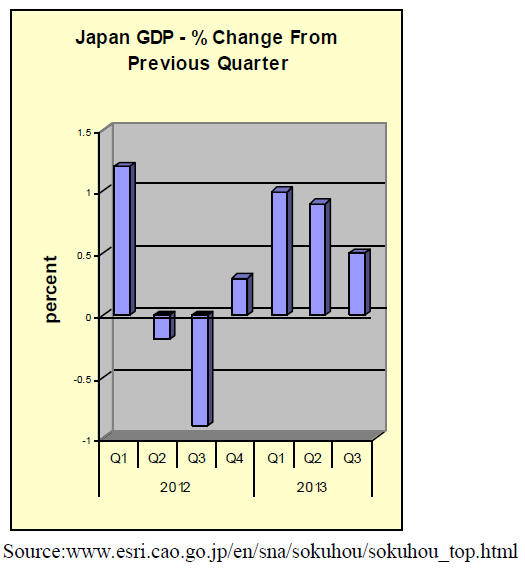
Exports in the third quarter fell 0.6% from the previous
quarter and growth in personal consumption remained
virtually unchanged. However, personal spending over the
next months until the introduction of the higher
consumption tax is expected to remain strong but weaker
exports could become a major threat.
Exports of Japanese cars to the US have fallen recently
and the export of electronic goods, especially to Asian
markets, have been hit by currency weakness in these
markets.
In the medium term the Japanese government is pinning its
hopes on public works spending to maintain growth
momentum. Public works spending in the third quarter
rose almost 7% from the previous quarter and more money
will be pumped into public works projects. This, and
strong growth in the housing market is expected to sustain
growth at least until the end of the financial year in March
2014.
Fragile consumer confidence undermines prospects
for growth
Japan consumer confidence fell sharply in October as did
the index for willingness to buy durable goods. The
October decline was the sharpest since the crash after the
March 2011 mega quake.
The sudden turn-around in consumer confidence
highlights the fragility of the recent recovery and sends a
strong message to the government that ordinary people are
not sharing the benefits of recent economic gains.
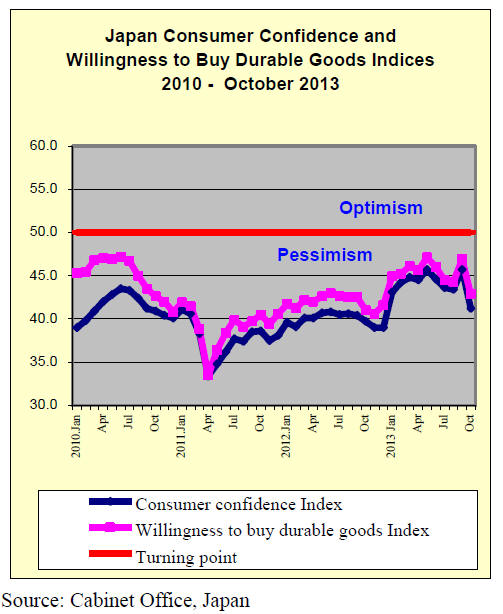
The Japanese Cabinet Office, which compiles the
consumer confidence index, suggested that the mid-
October typhoon which caused severe damage in the west
of the country undermined sentiment. The announcement
during the month that the sales tax in Japan will be raised
is cited as another reason for the weaker data.
Small businesses not feeling benefits of recent growth
The Japanese central bank has indicated that it now
expected the economy to expand 1.5 percent in the year
starting next April, up from a previous forecast of 1.3
percent. The weaker yen is making Japanese goods more
competitive and that has helped corporate earnings
recover.
But, ordinary Japanese families and small businesses have
not felt the benefits of recent growth and many say
conditions in the real economy are worse than last year.
All Japanese economists know the hardest work is yet to
be tackled especially structural reforms to make all
businesses, large and small, more competitive.
Other areas that need addressing include making the
labour market more flexible, improving productivity and
bringing more women into the work force.
In a growth strategy announced mid year the government
signaled its intention to establish „special economic zones‟
where some regulations would be relaxed and conditions
put in place to attract foreign investors. However, the
specifics of all these good ideas have yet to be announced.
One analyst said “There is a sense that the series of
announcements earlier this year have been replaced by
mere supporting statements and no action.
Is inflation target slipping?
In its latest forecasts the BoJ seems to be hinting that the 2
percent inflation target for two years from now will not be
achievable but said it would maintain its financial stimulus
policy as long as needed to get the country out of
deflation.
On a brighter note the Bank of Japan (BoJ) revised
upwards its growth forecast for fiscal 2014 to 1.5 percent
from the previous forecast of 1.3 percent as it expects
growth to continue despite the slowing expected when the
sales tax is increased next year.
The BoJ is sticking to its monetary stimulus policy which
began in April to meet its target of lifting inflation. In its
semi-annual outlook report, the BoJ kept its forecasts for
core consumer inflation in fiscal 2014 at 1.3 percent rising
to 1.9 percent in 2015.
Economists have voiced concern that the BoJ is over
optimistic of the impact of the government plans to
minimize the impact of the rise in the consumption tax to 8
percent next April.
Emerging Asian economies turn the corner
In a recent assessment the BoJ noted the beginnings of
economic recovery in the United States, Europe and China
and this has helped slow the pace of economic declines in
much of the rest of Asia where there are now signs of
expanded manufacturing output.
The economies in emerging Asia grew rapidly in the years
after the financial crisis but slowed sharply over the past
few years because of continued weak demand especially in
Europe and a cooling of growth in China and India.
According to the Asian Development Bank, growth in the
region slowed from 9 percent in 2010 to about 6 percent
this year. However, new data suggests a more optimistic
picture for future growth.
Yen weakens marginally
The Japanese yen has weakened slightly over the past
week but is still below the 100:US$ mark. The Central
Bank is being very careful to monitor exchange rates and
has a deliberate policy of holding the yen down to aid
exporters.

Trade news from the Japan Lumber Reports (JLR)
The Japan Lumber Reports (JLR), a subscription trade
journal published every two weeks in English, is
generously allowing the ITTO Tropical Timber Market
Report to extract and reproduce news on the Japanese
market.
The JLR requires that ITTO reproduces newsworthy text
exactly as it appears in their publication.
For the JLR report please see:
http://www.nmokuzai.
com/modules/general/index.php?id=7
Japan China wood use seminar
JETRO (Japan External Trade Organization) and the Japan
Wood Products Export Promotion Council held wood
utilization and export promotion seminar for Japan and
China and reported wooden house situation and progress
of Chinese wood structural design standard in China.
JETRO reported that the government is targeting to double
the amount of export of agricultural and marine products
by 2020 and wood is one of eight priority items.
Actually wood products export has been growing after the
yen weakened and price increase of competing North
American wood products and revision of Chinese building
standard.
Five Chinese specialists were invited to learn about recent
situation in China.
Regarding revision of wood structural design standard of
China, Japanese cedar, cypress and larch have a good
chance to be listed as structural material and Japanese post
and beam construction will be listed as one of construction
styles.
One Chinese specialist reported that demand for wooden
house is large in China and house builders actually build
2x4 units, log house and units of laminated lumber.
Another specialist reported that height of Chinese house is
normally 3 meters and sometimes 4 meters, which is
higher than Japanese house. Size of guest room is 45-50
square meters and bed room is 30 square meters so span is
wide.
Accordingly size of post is 150 mm and beam is 350 mm
or larger. There is no standard on structure by metal
fasters.
There will be large change after the standard in China is
revised for wooden buildings. China is large country and
climate varies by the regions so different view is necessary
by the region. When ones intend to go to China market to
sell wooden units, what ones need to pay attention is to
consider Chinese taste of using wood post and beam as
exposed, much larger size of house unit in China and
importance of durability.
South Sea (tropical) logs
Suppliers‟ proposals for export logs are firming after rain
started since mid October and the region is in rainy season
now. This means log production would drop and supply
would get tight.
Right at this moment there have not been much influence
by rain yet but log supply is gradually dropping. India
resumed active purchase after their currency Rupee is
being appreciated.
Rainy season is here then Malaysia will have the New
Year holidays in mid January when workers take days off
so log supply will certainly drop and the prices would
inflate.
This is just in between stagnant market and escalating
market after log prices trended on weak side for last
several months.
Log prices of some type are already going up. Low grade
log prices for India in Sarawak are now $230-240 per cbm
FOB, $10 up from October.
Sarawak meranti regular prices are about $280 per cbm
FOB. Small meranti prices are about $240 and super small
are $220. They are all firming. Sabah‟s seraya FOB prices
are about $260 and kapur regular are about $370. PNG is
suffering foul (harvesting) weather.
The log market in Japan continues high but due to
difficulty to pass higher log cost onto plywood, actual
prices are softening. Sarawak meranti regular prices are
about 10,100 yen per koku CIF, slightly down from October.
Akita Plywood intensifies floor base production
Akita Plywood (Akita prefecture), increases floor products
after it expanded floor manufacturing facility. Production
of floor base (9.0-11.5 mm thick/3x6) is 50,000 sheets a
month since last August, which is almost double of former
production. It targets to make it 100,000 sheets a month in
near future by improvement of the facility.
With declining housing starts and demand for structural
materials, the company intends to develop market of
softwood plywood to non structural product.
To increase floor base production, the first plant
introduced semi automatic veneer setter and joint machine
for 6 feet long veneer in July. The second floor plant
renewed sticker facility of floor base and MDF. Newly
introduced are two cold press and one adhesive roll coater.
Akita Plywood is the largest plywood manufacturing
company and its consumption of cedar logs is about
40,000 cbms a month for three plants. Its softwood floor
base plywood is made of Hokkaido fir for face and back
with cedar core. Thin MDF is used as cushion between
floor base and surface materials of floor.
In manufacturing domestic softwood floor base plywood,
smoothness is required even for core veneer so that quality
cedar logs are necessary. Akita is famous area for quality
cedar so the plants are in advantageous location.
September housing starts
Total starts in September were 88,539 units, 19.4% more
than the same month a year ago. This is the consecutive
increase of thirteen months.
Seasonally adjusted annual starts are 1,040,000 units,
8.3% more than September last year.
The boom seems to be triggered by coming consumption
tax raise and rising mortgage interest rate. September is
the deadline of orders to apply 5% tax so there were heavy
last minutes rush orders in September so it is doubtful that
the boom would last after September.
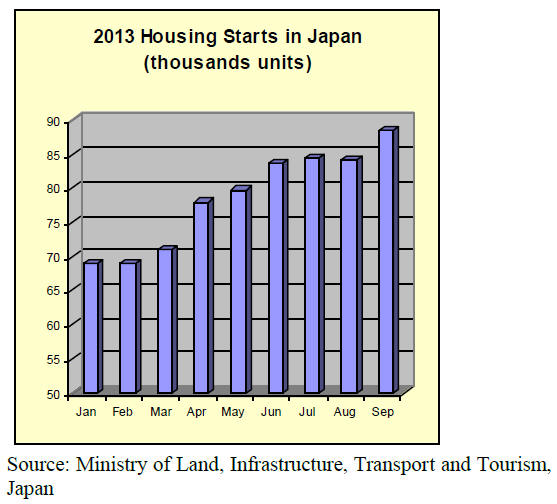
By category, owners unit, rental units and units built for
sale are all increased over a year ago level as shown in the
chart. Particularly, units built for sale recorded over
20,000 units as deliveries can be made before the tax is
increased since April next year, which is seasonally
unusual.
Owners units also recorded over 30,000 units for four
straight months and increase for 13 consecutive months.
Rental units also increased for seven consecutive months.
Wood based units were 49,113, 14.2% more out of which
traditional post and beam units were 36,913, or 14.6%
more. Starts in the earthquake damaged three prefectures
continue brisk. Particularly rebuilding of owner‟s units is
active.
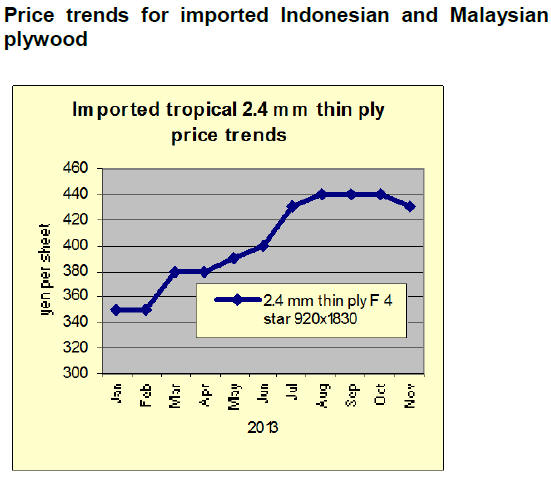 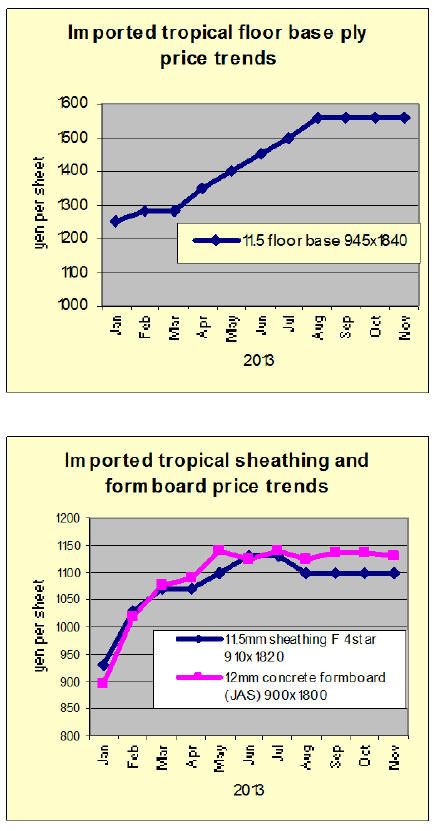
|